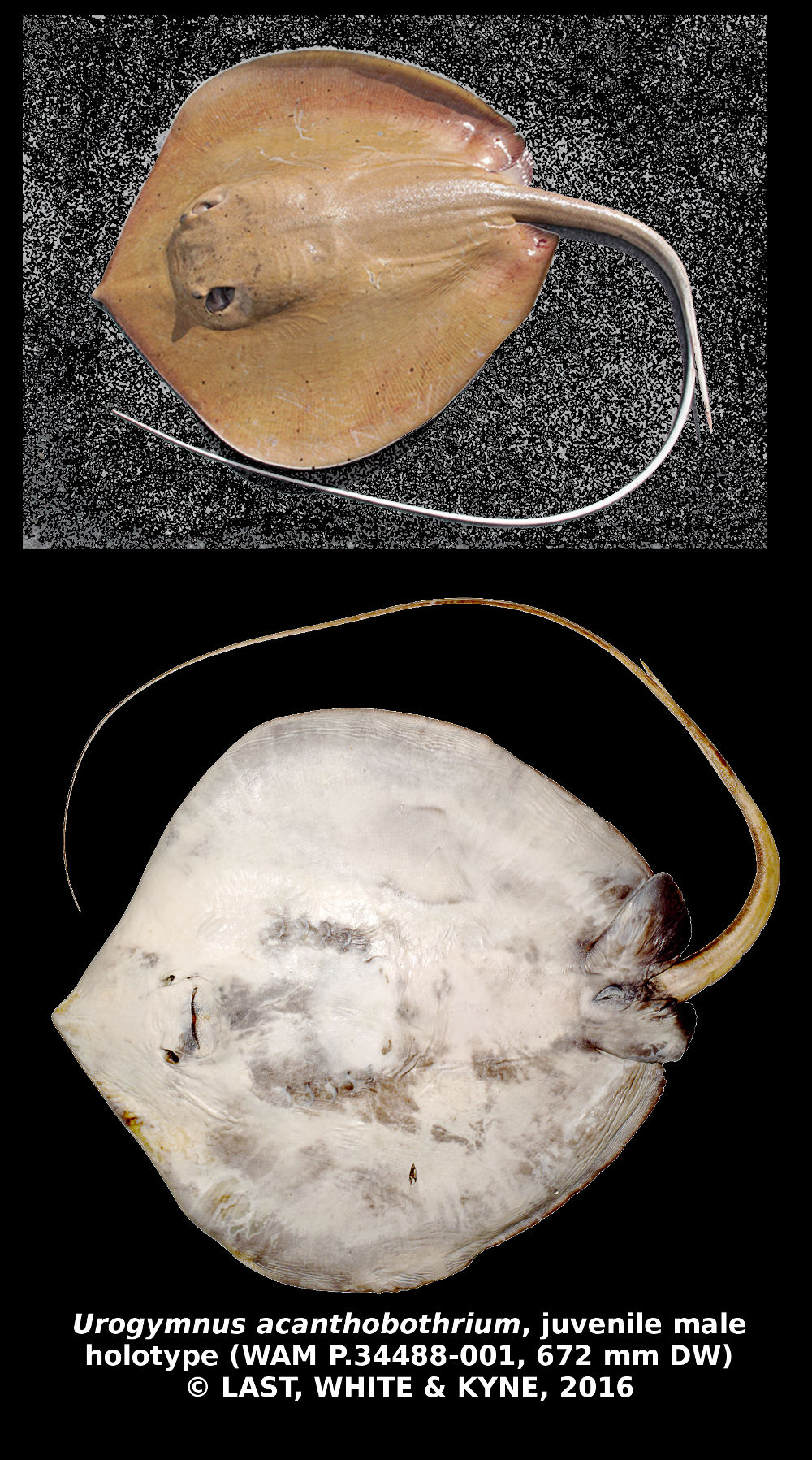Urogymnus acanthobothrium
Last, White & Kyne, 2016
Mumburarr Whipray
Classification: Elasmobranchii Myliobatiformes Dasyatidae
Reference of the original description
Urogymnus acanthobothrium sp. nov., a new euryhaline whipray (Myliobatiformes: Dasyatidae) from Australia and Papua New Guinea. Zootaxa, 4147(2), 162–176
Urogymnus acanthobothrium sp. nov., a new euryhaline whipray (Myliobatiformes: Dasyatidae) from Australia and Papua New Guinea. Zootaxa, 4147(2), 162–176
Description :
Citation: Urogymnus acanthobothrium Last, White & Kyne, 2016: In: Database of modern sharks, rays and chimaeras, www.shark-references.com, World Wide Web electronic publication, Version 05/2025
Please send your images of "Urogymnus acanthobothrium" to info@shark-references.com

Urogymnus acanthobothrium sp. nov, juvenile male holotype (WAM P.34488-001, 672 mm DW) © Last, White & KYNE, 2016

Urogymnus acanthobothrium sp. nov, juvenile male holotype (WAM P.34488-001, 672 mm DW) © Last, White & KYNE, 2016
Common names
 Mumburarr Whipray
Mumburarr Whipray
 Mumburarr Whipray
Mumburarr Whipray
Short Description
Original diagnosis after LAST, WHITE & KYNE, 2016 [24344]: A species of Urogymnus distinguished by a combination of the following characters: disc elongate suboval, snout tip to axis of maximum width 53% DW; anterior disc margin not truncated, almost straight, lateral apices broadly rounded; preorbital snout broadly angular, angle 114°, with a very small apical lobe; preorbit long, length 26% TL, 2.1 times interorbital length; orbits small, protruded slightly; spiracle very large, 8.6% DW, 1.9 in orbit diameter; internasal distance 2.0 in prenasal length, 2.8 times nostril length; preoral snout length 2.6 times mouth width, 2.5 times internarial distance; caudal sting very large, length more than a 30% DW; mid-scapular denticles very small and inconspicuous; secondary denticles very small, rather widely spaced, band delimited but margin not sharply defined, band truncate forward of eye; minute upright tertiary denticles present, barely visible; low and short-based ventral tail fold present; dorsal disc colour variable, plain dark greyish brown to yellowish brown in juveniles, very finely and faintly mottled greyish white to yellowish brown in adults; ventral surface largely white, posterior disc without regular dark margins; tail beyond sting white in young, unknown but possibly paler than anterior tail in adults; propterygial radials 66, 3 times the number of mesopterygial radials; total vertebral segments (excluding synarcual) 151.
Original diagnosis after LAST, WHITE & KYNE, 2016 [24344]: A species of Urogymnus distinguished by a combination of the following characters: disc elongate suboval, snout tip to axis of maximum width 53% DW; anterior disc margin not truncated, almost straight, lateral apices broadly rounded; preorbital snout broadly angular, angle 114°, with a very small apical lobe; preorbit long, length 26% TL, 2.1 times interorbital length; orbits small, protruded slightly; spiracle very large, 8.6% DW, 1.9 in orbit diameter; internasal distance 2.0 in prenasal length, 2.8 times nostril length; preoral snout length 2.6 times mouth width, 2.5 times internarial distance; caudal sting very large, length more than a 30% DW; mid-scapular denticles very small and inconspicuous; secondary denticles very small, rather widely spaced, band delimited but margin not sharply defined, band truncate forward of eye; minute upright tertiary denticles present, barely visible; low and short-based ventral tail fold present; dorsal disc colour variable, plain dark greyish brown to yellowish brown in juveniles, very finely and faintly mottled greyish white to yellowish brown in adults; ventral surface largely white, posterior disc without regular dark margins; tail beyond sting white in young, unknown but possibly paler than anterior tail in adults; propterygial radials 66, 3 times the number of mesopterygial radials; total vertebral segments (excluding synarcual) 151.
Distribution
Gulf of Papua, Papua New Guinea, and northern Australia (Fig. 8), in brackish reaches of tidal rivers and estuaries, and marine waters [24344]
Gulf of Papua, Papua New Guinea, and northern Australia (Fig. 8), in brackish reaches of tidal rivers and estuaries, and marine waters [24344]
Size / Weight / Age
adult female max. 1740 mm DL, a late embryo ~265 mm DW, Juveniles (n=5) measured 390–672 mm DW, 430–720 mm DL [24344]
adult female max. 1740 mm DL, a late embryo ~265 mm DW, Juveniles (n=5) measured 390–672 mm DW, 430–720 mm DL [24344]
Dentition
Teeth small, broadly subtriangular to rhomboidal, in quincunx; similar in size in upper and lower jaws; surfaces of crowns strongly crenulate. Tooth rows in upper jaw ~40, in lower jaw >40, difficult to count without further dissection [24344]
Teeth small, broadly subtriangular to rhomboidal, in quincunx; similar in size in upper and lower jaws; surfaces of crowns strongly crenulate. Tooth rows in upper jaw ~40, in lower jaw >40, difficult to count without further dissection [24344]
Remarks
shark-references Species-ID=14667;
shark-references Species-ID=14667;
Parasites (arranged by Jürgen Pollerspöck)
Cestoda
Cestoda
- Acanthobothrium oceanharvestae Fyler, Caira & Jensen, 2009 [28741]
- Acanthobothrium popi Fyler, Caira & Jensen, 2009 [28741]
- Acanthobothrium rodmani Fyler, Caira & Jensen, 2009 [28741]
- Acanthobothrium romanowi Fyler, Caira & Jensen, 2009 [28741]
- Acanthobothrium zimmeri Fyler, Caira & Jensen, 2009 [28741]
















